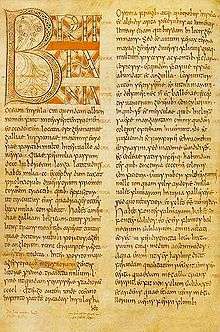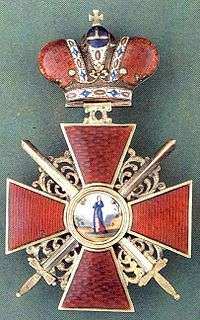Peter P. Dubrovsky
| Peter P. Dubrovsky | |
|---|---|
| Born |
January 9, 1754 Kiev, Russian Empire |
| Died |
January 9, 1816 (aged 62) Saint Petersburg, Russian Empire |
| Occupation | paleographer, diplomat |
| Known for | manuscript collector |
Peter Petrovich Dubrovsky Russian: Пётр Петрович Дубровский (born January 9 (?) 1754 in Kiev, died January 9, 1816 in Petersburg), was a Russian bibliophile, diplomat, paleographer, secretary of the Russian Embassy in France, collector of manuscripts and books. Throughout his life he collected about 2000 manuscripts.[1] Between 1805 and 1812 he worked at the Imperial Public Library.
Life


In 1772 Dubrovsky finished his studies at the Kyiv-Mohyla Academy in Kyiv (Russian: Киево-Могилянская академия). In 1773 he served as a copyist in the Synod. Between 1780 and 1805 Dubrovsky worked in the Board of foreign affairs as a churchman at the Russian ambassadorial church in Paris and as a secretary-translator for embassies in France and Holland.[2]
During the French Revolution he acquired manuscripts and documents, which were stolen from the public libraries in France. Most of them were stored at the Bastille, in the Saint-Germain-des-Prés, and the monastic Library of Corbie Abbey.[3] They were not safe because the Jacobin mobs plundered French cities.[4]
In February 1800, Dubrovsky returned to Petersburg with a collection of 400 Western European medieval manuscripts, miniatures, and early books.[5] Somehow he came into possession of 94 manuscripts from the East (in Greek, Persian, Arabian, Hebrew and 11 other languages), about 50 Slavic manuscripts.[2] In England some proposals were made to Dubrovsky; he was offered a fabulous sum for his collection, but he flatly refused negotiations with foreigners, having declared that it was his sincere desire to transport the collection home.[2]
In his collection there were also some runic books from the collection of Anne Queen of England (this collection has been lost).[1] and the Saint Petersburg Bede, an Insular 8th-century manuscript of the Historia ecclesiastica gentis Anglorum of the English People written by Venerable Bede.[6]
Originally Dubrovsky's collection did not interest the Russian imperial court, as he had hoped. That is why he resorted to forgery and asked his friend Alexander Sulkadziev to forge an inscription on one of the Cyrillic manuscripts of the collection on behalf of Anne of Kiev who in the 11th century married Henry I of France. This allowed Dubrovsky to allege that some of his Cyrillic manuscripts are from the library of Anne of Kiev. For this reason Alexander I of Russia accepted the collection as donation. Only recently it was established that the manuscript with inscription allegedly by Anne of Kiev is in fact a Serb manuscript of the 14th century.[7]
In 1805, Dubrovsky donated the manuscripts to the Imperial Public Library, where his collection became the basis of the "Manuscript Depository". He received the Anna's award of the 2nd class.[2] He was appointed as a keeper of the manuscripts under an offer by the Department of Manuscripts (Russian: Депо манускриптов). He described every document in his collection. Unfortunately some of the descriptions were lost.[2]
He examined and described 11 000 manuscripts, dispatched from the Załuski Library, after the second Partition of Poland and Kościuszko Uprising.[2]
He was discharged from the post on 5 April 1812. Dubrovsky wrote: "Жизнь наша коротка, все условия, все награды с нею кончаются, но полезное для ума человеческого служит до окончания мира" (Our life is short, all conditions, all awards with it come to an end, but useful to the mind of human serves before the termination of the world).[2]
After his death, no any valuable items were found in his private collection. He took to the grave the secret of the runic books.[2]
According to Graham Stewart, a journalist: "We should recognise that Dubrovsky did not just Russia a favour, but also the world," because he rescued many manuscripts from possible destruction.[4]
Some manuscripts acquired by Dubrovsky
- Codex Sangermanensis
- two leaves from Codex Coislinianus
- Codex Corbeiensis I
- Minuscule 330
- Lectionary 246
- Lectionary 247
- Lectionary 253
- Lectionary 254
- part of the manuscript of Origen's Homiliae (MS. Lat. F v I 4)[8]
- The manuscript of the Breviloquium Vitae Wilfridi[9]
- Saint Petersburg Bede, the 8th-century manuscript of the Historia ecclesiastica gentis Anglorum of Bede
References
- 1 2 "РУНИЧЕСКИЕ КНИГИ ИЗ БИБЛИОТЕКИ АННЫ ЯРОСЛАВНЫ". Retrieved 25 September 2010.
- 1 2 3 4 5 6 7 8 Дубровский Петр Петрович История в лицах
- ↑ About the Library of Corbie see: Leopold Delisle, "Recherches sur I'ancienne bibliotheque de Corbie", Memoires de l'academie des inscriptions et belles-lettres, Paris, Vol. 24, Part 1 (1861), pp. 266-342.
- 1 2 Times Online, December 12, 2009
- ↑ The State Hermitage Museum
- ↑ Joanna Story, Anglo-Saxon England and Carolingian Francia, c. 750-870, 2003.
- ↑ Исторический обман
- ↑ Burney 340 - Origen, Homiliae
- ↑ Machael Lapidge, Anglo-Latin Literature 900-1066 (London, Rio Grande 1993), p. 171.
Further reading
- Луизова Т. В., Собрание рукописей П. П. Дубровского в Государственной публичной библиотеке им. М. Е. Салтыкова-Щедрина//Вопр. истории. 1952. № 8;
- Воронова Т. П., П. П. Дубровский - первый хранитель "Депо Манускриптов" Публичной библиотеки //Археогр. ежегод. за 1980 г. М., 1981;
- Воронова Т. П., Первые описи собрания П. П. Дубровского//Проблемы научного описания рукописей и факсимильного издания памятников письменности: Материалы Всесоюз. конф. Л., 1981;
- Logutowa M., Insular Codices from Dubrovsky's Collection in the National Library of Russia, in Kilpiõ and Kahlas-Tarkka, Ex Insula Lux, pp. 93–98.
- Thompson P. Z., Biography of a Library: The Western European Manuscript Collection of Peter P. Dubrovski in Leningrad, The Journal of Library History, 19 (1984), pp. 477–503.
- Lyons S., "Music in the Odes of Horace", Oxford, Aris & Phillips, 2010, pp. 135–178, ISBN 978-0-85668-844-7.